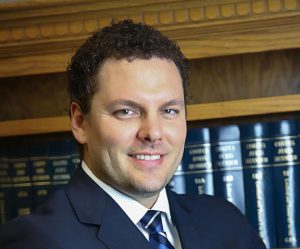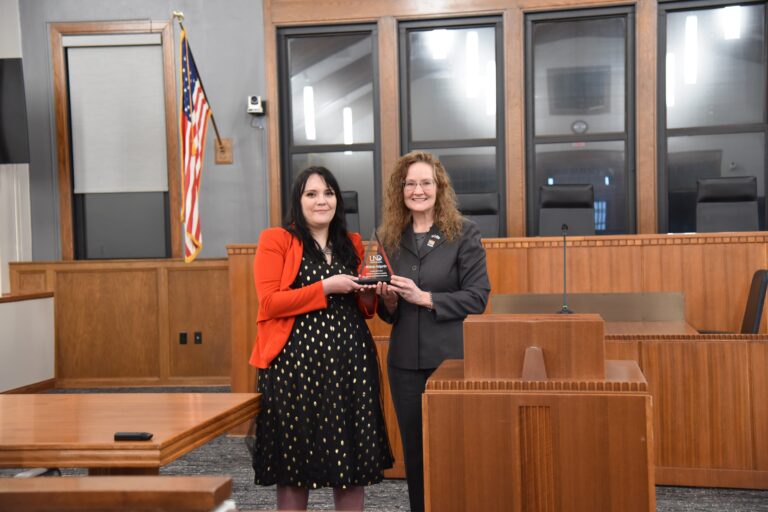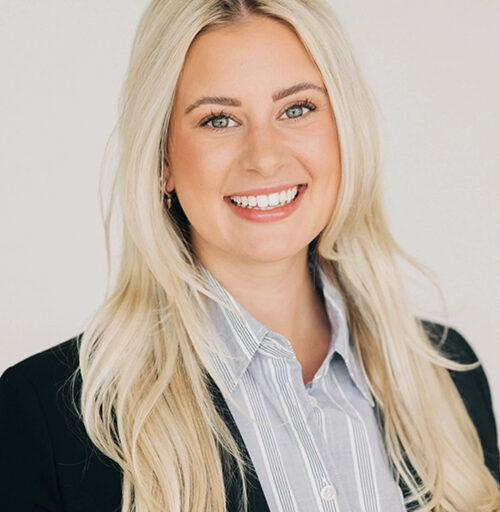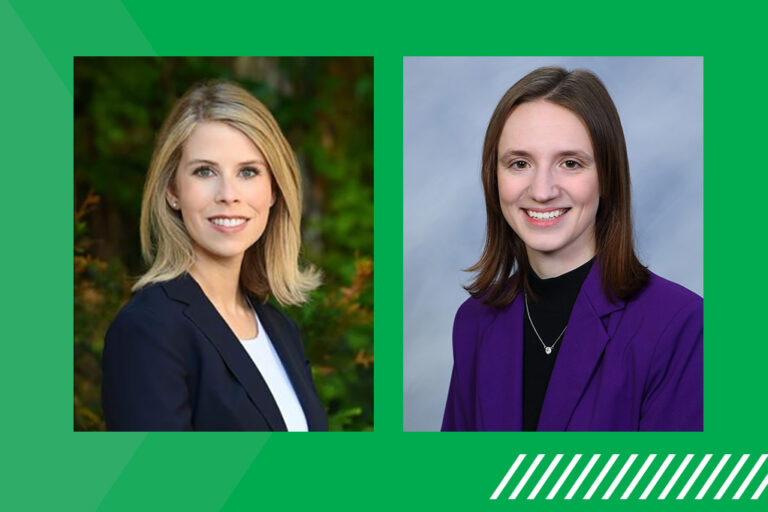GFH Story featuring alumnus Josh Wolfe – Law firms, UND work to combat shortage of rural attorneys
 Original Article – Grand Forks Herald, By: Andrew Weeks, December 29th 2019
Original Article – Grand Forks Herald, By: Andrew Weeks, December 29th 2019
Challenges still exist, but the outlook is trending more positively, especially with partner programs between law firms, universities and other organizations.
When Josh Wolfe was a teenager living on his family’s farm in a rural North Dakota community, he picked up a book that pointed him to his career.
By the time he finished reading “To Kill a Mockingbird,” the modern classic by Harper Lee, he knew he wanted to become a lawyer. Not just any lawyer, however, but one who exemplified the values of the book’s protagonist, Atticus Finch.
“I learned from reading that book that there are lawyers with moral character,” Wolfe said.
Wolfe knew that even though Finch was a fictional character, he could take lessons from the book and apply them to his own life and career. He said lawyers often get a bad rap as being sleazy, money-hungry fakes, but he wanted to honor the profession by being a hard worker with a deep concern for his clients and the justice system.
There was something else about the book that resonated with Wolfe: lawyering in a small town.
Lee sets her novel in the “tired old town” of Maycomb, Ala. Wolfe works as an associate attorney in general practice with the firm Olson & Burns based Minot, N.D., but once a week makes the roughly 60-mile trip to the much smaller town of Kenmare. It is in this town, which has a population of a little more than 1,000 people by the latest census estimates, where out of the community room of a local bank he works with residents seeking legal advice in the rural community.
His being there once a week is a way for people to access an attorney without having to drive long distances themselves, one of the challenges many rural communities are faced with if they don’t have town-based legal counsel.
Wolfe is one example of how law firms and lawyers are trying to combat the shortage of attorneys in small-town America. While challenges still exist on this front, the outlook is trending more positively, especially with partner programs between law firms, universities and other organizations.
Wolfe, a graduate of the UND School of Law, was part of a pilot program that started in 2014 to get law students to intern with judges in rural areas. The program was a collaborative effort between the university, the North Dakota Supreme Court and the State Bar Association of North Dakota, but the following year it expanded with a grant from the Edson & Margaret Larson Foundation.
Wolfe clerked for Judge John C. McClintock Jr., chambered in Rugby, N.D., where he became familiar with both the challenges and rewards of working in a small community. That familiarity expanded when he started working for Olson & Burns a year later and was put in charge of operating its satellite office in Kenmare. He said if young attorneys want to make their mark and their money, practicing in small towns isn’t a bad option.
The challenge is that for years there hasn’t been enough attorneys who want to work in the smaller communities.
That doesn’t mean that the legal profession is declining. On the contrary, according to a 10-year survey by the American Bar Association, the number of attorneys nationwide increased by 14.5% since 2009. Of Prairie Business magazine’s three-state coverage area – North Dakota, South Dakota and western Minnesota – only North Dakota saw a slight decline (0.4%) in the number of attorneys from 2018 to 2019. Also, the number of lawyers overall is projected to grow by 6% over the decade – or about as fast as the average for most occupations – according to the Bureau of Labor Statistics.
“Competition for jobs over the next 10 years is expected to be strong because more students graduate from law school each year than there are jobs available,” the report reads.
The number of students attending law school might once have been declining, but now numbers are trending the other way. The UND School of Law, for instance, saw a 33% increase in the number of law students during the 2018-19 school year, according to the law school’s dean, Michael McGinniss.
“We’re excited about that,” he said. “I think there’s, you know, some years back there was a decline in students applying to law schools around the country. The data is indicating that those applications have now been rising the past year.”
But the positive numbers mask the real-life problems that rural communities are faced with regarding the legal services business. Wolfe said he’s seen the problem firsthand and understands that attorneys, like anyone else in other fields, have to go where the money is, and a lot of young attorneys believe that’s in the bigger cities. That often means when a lawyer in a small community leaves the practice, there isn’t anyone else to continue the services.
“There’s a real vacuum taking place in rural communities,” he said. “You have attorneys in the small towns that are in their early to mid-60s, getting ready to retire, and there’s just not a young lawyer willing to come into these small communities and set up shop.”
Patrick Goetzinger, an attorney with Gunderson, Palmer, Nelson, Ashmore in Rapid City, S.D., and who serves on the American Bar Association Board of Governors, saw the same problem in his home state and at one time painted the picture with darker colors. Attorneys in rural communities, he said, including South Dakota, are a dying breed.
Or at least they were at one time, but now another scenario is trending.
New scenario
The outlook is slowly but surely improving, at least in some parts of the region. “I don’t think they are a dying breed anymore,” Goetzinger said. “Attorneys are now alive and well in South Dakota.”
Goetzinger founded Project Rural Practice in South Dakota, whose task force in turn prompted the state’s chief justice to come up with the Rural Attorney Recruitment program; basically, a measure for the Legislature to “throw money at the issue by creating a pool of dollars that would provide an incentive payment to lawyers that would relocate or establish a practice in qualifying rural communities,” he said. “As a result of appropriation that we received from the state of South Dakota, and the matching funds that came from the local community and our State Bar Foundation, we were able to pull $1 million that we could then use to provide an incentive payment for each year of a five-year period for the lawyers.”
The program started by placing 16 law students – dubbed the “Sweet Sixteen” – in 16 qualifying communities.
Goetzinger said he saw the writing on the wall for rural practices at least 20 years ago, when a lawyer in his hometown of Martin, S.D., left the only law firm in town. In doing so, it left the community without home-based legal counsel and no prospective attorneys to fill the void.
“We saw that happening from town to town, landscape to landscape, main street to main street, across the state where there were lawyers retiring from towns with no lawyers to take over and no prospects for successors,” he said.
When Project Rural Practice started in 2013 it aimed to get attorneys into counties with a population of fewer than 10,000 residents. Goetzinger said that 45 of South Dakota’s 66 counties qualified under that criteria, but new criteria has since been passed and much smaller populated towns within those counties have been served. Of the 32 permanent positions now available for funding, 24 are currently filled.
UND’s Rural Justice Program also has seen successes over the past few years, according to the law school’s dean, McGinniss.
He said the hope is that young attorneys in the program would get to know the community, residents would get to know them, and after graduating from law school the attorneys would settle into those same communities and start practicing law.
“The benefits are starting to be reaped from this initiative,” McGinniss said, noting the school has placed students from the program at several North Dakota locations such as Cavalier, Mayville and Spirit Lake Tribe, among others.
McGinniss said the university has plans to continue these efforts for the foreseeable future and applied for another grant through the Larson Foundation for the current school year.
The place to be
Much like Lee’s protagonist in “To Kill a Mockingbird,” Wolfe believes everyone is entitled to have their legal rights protected, no matter where they live, in a big city or small town. That is the crux and bonum why it is important to get legal counsel into rural communities.
“Everybody is entitled to have their legal rights protected,” he said, “whether it’s in a criminal setting, a family lawsuit or even in commercial litigation.”
There also are financial and other dividends that come from working in a rural practice. If an attorney is looking to get into the courtroom, a small town might be the place to do it. Also, as the larger industry is faced with fears of automation and artificial intelligence, something Prairie Business reported on in January 2019, a rural community law practice might be getting back to the very roots of the legal profession. There also usually is no dearth of work for the ambitious lawyer; the same cases that arise in big cities also happen in small towns.
Wolfe said legal work in rural communities is not just about tackling agriculture issues, as some might think. There’s that, of course, such as farm succession planning, but there’s also business succession planning, adoptions, criminal cases, divorces, estate planning, land sales, et al., basically all the things you’d see in a metropolitan area.
“The same legal issues that you see in Kenmare, you’d see in Fargo,” he said. “You still get the interesting cases in the small towns. … And you know, the same crimes are being committed, just maybe not as often, but you’re still seeing the same legal issues in the small towns as you see in the bigger cities.”
Just like in “To Kill a Mockingbird.”
Wolfe enjoys tackling the legal issues of rural America during his weekly visits to Kenmare. It is here, while sitting with a client in the bank’s community room, where he feels most attuned to his book hero Atticus Finch. His being there once a week has been a boon – for him, his clients, and the firm. He believes small communities in the upper Midwest are ripe for ambitious, young attorneys – or even senior ones – wishing to make their mark and their money.
“There’s definitely an opportunity out there in the smaller communities where an attorney, hanging his or her own shingle, can make a very livable career,” he said.


